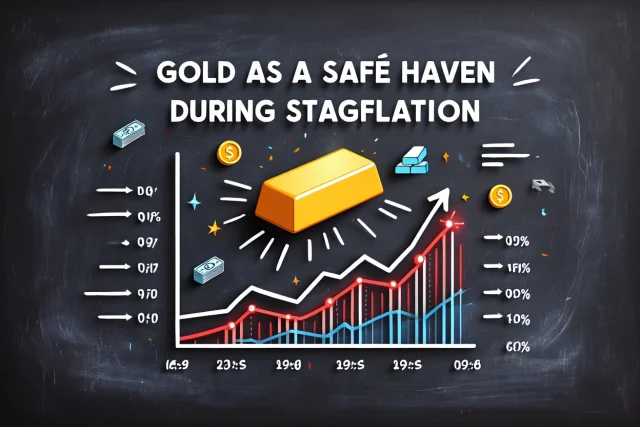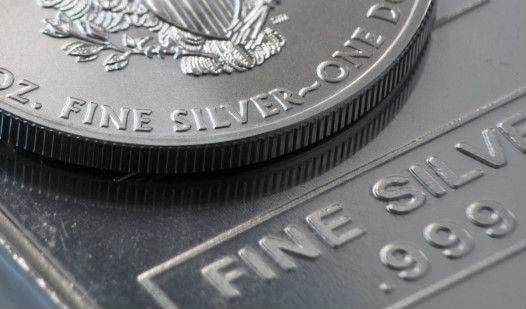The gold market has been a focal point for investors this week, with prices shattering records and breaching the $3,200 per ounce mark. Fueled by escalating safe-haven demand, growing stagflation concerns, and global economic uncertainty, gold’s meteoric rise has captivated financial markets. Let’s explore the implications of stagflation, and forecast where gold prices might head next in 2025.

Gold Prices Hit Unprecedented Levels: What Happened This Week?
Gold has been on a tear in 2025, and this week marked a historic milestone as spot prices soared past $3,200 per ounce, with a peak of $3,237.65 recorded on April 13. According to Reuters, gold jumped nearly 3% on Thursday April 10th alone, driven by a weakening U.S. dollar and intensifying U.S.-China trade tensions. By Friday, bullion solidified its position above $3,200, a level unimaginable just a few years ago. The rally spanned international markets. In India, gold prices hit ₹93,390 per 10 grams, reflecting global trends. Posts on X echoed the sentiment, with analysts like @PiQSuite noting that “gold prices surged to record highs amid safe-haven demand and tariff concerns.” This week’s breakout underscores gold’s role as a go-to asset during turbulent times, but what’s fueling this unprecedented demand?
Key Drivers of Gold’s Record-Breaking Week
Safe-Haven Demand Surges Amid Global Chaos. Gold’s reputation as a safe-haven asset has been supercharged by geopolitical and economic instability. The escalation of the U.S.-China trade war, sparked by President Donald Trump’s new tariffs, has sent shockwaves through global markets. Reuters reported that fears of a global recession, coupled with a faltering dollar, drove investors to gold in droves. Beyond trade tensions, geopolitical risks—such as the Russia-Ukraine conflict and Middle East uncertainties—continue to bolster gold’s appeal. The World Gold Council highlighted that central banks, including China’s, are stockpiling gold, with China adding to its reserves for the fifth consecutive month. This institutional buying spree has tightened supply, pushing prices higher.
Stagflation Fears Take Center Stage
Stagflation—a toxic mix of stagnant economic growth and rising inflation—has reemerged as a buzzword in 2025. Federal Reserve Chair Jerome Powell warned this week that Trump’s tariffs could lead to “higher inflation and slower growth,” classic stagflation precursors, according to Investopedia. Gold thrives in such environments, as it’s seen as a hedge against inflation eroding purchasing power.
Business Today noted that “concerns regarding stagflation in the U.S. are further bolstering gold’s attractiveness.” With U.S. consumer prices unexpectedly falling in March but tariff-driven cost increases looming, investors are betting on gold to preserve wealth amid economic uncertainty.
Central Bank Policies and Interest Rate Expectations
The Federal Reserve’s signals of potential rate cuts in 2025 have also played a pivotal role. Reuters reported that traders now expect around 90 basis points of cuts by year-end, starting as early as June. Lower interest rates reduce the opportunity cost of holding non-yielding assets like gold, making it more attractive.
Meanwhile, central banks’ aggressive gold purchases—removing thousands of metric tons from the market—have created a supply-demand imbalance. As one analyst on X (@AlvaApp) put it, “Central banks stacking gold, led by China,” are a key force behind the rally.
Dollar Weakness and Equity Market Woes
A weaker U.S. dollar this week amplified gold’s allure, as the two assets often move inversely. The S&P 500, down 10.6% year-to-date, has struggled under the weight of tariff fears, while gold has surged 23%, per CNBC. Investors fleeing volatile equities have poured funds into gold ETFs, with Chinese gold ETFs seeing record inflows.
Stagflation and Gold: A Perfect Storm?
Stagflation is a rare and dreaded economic phenomenon, last seen prominently in the 1970s. This week, warnings from Fed officials and analysts have reignited fears that the U.S. could be on the brink. Tariffs, which act as a supply shock by raising the cost of imported goods, are a major culprit. Investopedia explains that “tariffs, like those introduced in 2025, can contribute to stagflation by increasing prices for consumers and businesses.” Gold’s historical performance during stagflation makes it a natural beneficiary. In the 1970s, gold prices skyrocketed as inflation soared and growth stalled. Today, with the U.S. national debt surpassing $36 trillion and global debt levels ballooning, investors are turning to gold as a tangible store of value. BusinessToday reported that “gold has recorded all-time highs 20 times in 2025 alone,” a testament to its resilience. However, stagflation isn’t guaranteed. Some analysts argue that the Fed’s proactive stance could mitigate inflationary pressures. Still, the uncertainty itself is enough to keep gold in the spotlight, as investors hedge against worst-case scenarios.
Record Prices: Is Gold in a Bubble?
With gold prices smashing through $3,200, a natural question arises: Are we in a bubble? FX Empire cautioned that “gold may be in the final stages of a blowoff phase,” potentially peaking as early as next week. Historically, gold rallies often precede sharp corrections, as seen in 2022 when prices climbed 13% before retreating. Yet, many experts remain bullish. UBS raised its gold price forecast to $3,500 per ounce, implying 10% upside from current levels, citing “macroeconomic concerns and the need to diversify into safe havens.” Deutsche Bank is even more optimistic, projecting an average price of $3,139 for 2025 and $3,700 for 2026. These forecasts hinge on sustained safe-haven demand and limited supply growth. On the flip side, profit-taking could trigger short-term pullbacks. Livemint noted that “gold futures faced heavy profit booking” on Friday, with prices dipping to $2,985 briefly before recovering. Technical analysts point to the 50-day moving average near $2,943 as critical support. If this holds, gold could push toward $3,350 by year-end, as Deutsche Bank predicts.
Where Will Gold Prices Go in 2025?
Predicting gold prices is notoriously tricky when trading gold, but several factors will shape the trajectory in 2025:
Trade War Fallout
If U.S.-China trade tensions escalate further, gold could test $3,500 or higher. However, a de-escalation—unlikely in the near term—might ease safe-haven demand, capping upside.
Federal Reserve Policy
The Fed’s rate-cutting cycle will be crucial. Two anticipated cuts in 2025, as signaled this week, could propel gold toward $3,400. Conversely, a hawkish pivot to combat tariff-driven inflation might pressure prices.
Central Bank Buying
Central banks, particularly in Asia, show no signs of slowing their gold purchases. This structural demand could keep a floor under prices, even during corrections.
Geopolitical Risks
Ongoing conflicts and U.S. debt concerns will likely sustain gold’s safe-haven status. A major escalation, such as a breakdown in Russia-Ukraine talks, could drive prices to $3,600 or beyond.
How Investors Can Navigate the Gold Market
For those eyeing the gold market, here are actionable insights based on this week’s developments:
- Diversify with Gold ETFs: ETFs offer exposure without the hassle of physical storage. Global ETF inflows are rising, per BusinessToday, making this a timely option.
- Monitor Technical Levels: Watch the $2,943 support and $3,350 resistance for trading opportunities. A break above $3,237 could signal further gains.
- Hedge Against Stagflation: Allocate 5-10% of your portfolio to gold to protect against inflation and equity volatility.
- Stay Informed: Follow gold market news and central bank announcements, as policy shifts can sway prices rapidly.
Conclusion: Gold’s Golden Moment in 2025
This week’s gold market news underscores the metal’s enduring appeal amid chaos. Record prices above $3,200, driven by safe-haven demand, stagflation fears, and a weakening dollar, have cemented gold’s status as a must-watch asset. While short-term corrections are possible, the outlook for 2025 remains bullish, with forecasts ranging from $3,350 to $3,876.77. As trade wars rage, central banks hoard, and stagflation looms, gold’s role as a hedge against uncertainty has never been clearer. Investors searching for gold price trends 2025, safe-haven investments, or stagflation hedges should keep a close eye on this dynamic market. Will gold hit $3,500 by year-end? Only time will tell, but for now, the yellow metal is shining brighter than ever.
Sources: Reuters, BusinessToday, CNBC, FXEmpire, Investopedia, LiteFinance, Kitco News, posts on X



